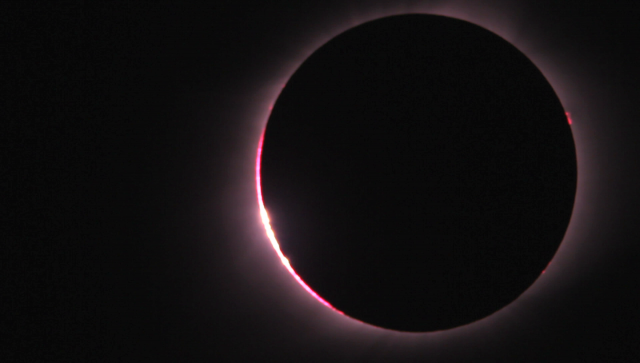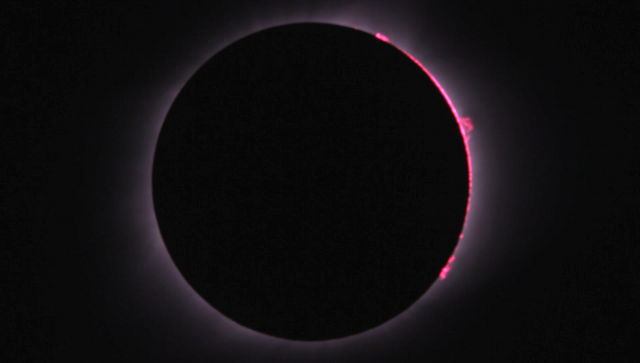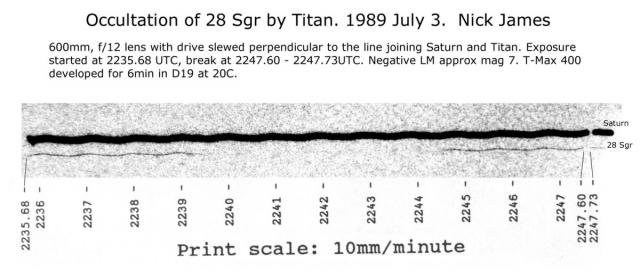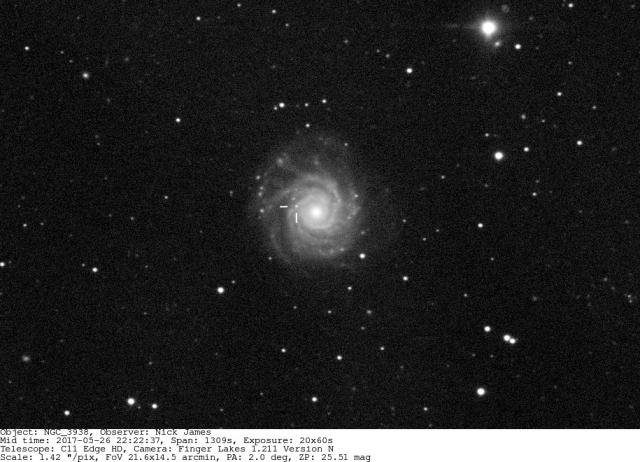Forum Replies Created
-
AuthorPosts
-
 Nick JamesParticipant
Nick JamesParticipantIndeed some fantastic images. I particularly like the skyscape ones.
 Nick JamesParticipant
Nick JamesParticipantRobin,
Many thanks for all of your help with this. An interesting result and a very steep learning curve for me!
Nick.
 Nick JamesParticipant
Nick JamesParticipantWe’ve received the calibrated 2D spectrum which was obtained by Richard Miles using the FTN but can’t make much sense of it. One of the FITS files is attached and if anyone has any insight it would be appreciated. According to the FITS header I think the left hand end corresponds to 474.2 nm and the scale is 0.3511 nm/pix. This would put H-alpha at around X=518 but there is no sign of anything there. I need to delve into the FLOYDS documentation but if anyone has any ideas I’d be very pleased to hear them!

 Nick JamesParticipant
Nick JamesParticipantRichard Miles tells me that the 2.0m FTN has acquired a spectrum using the FLOYDS spectrograph. The raw data will be processed after the telescope closes for the night. Richard sent me the attached image showing the raw spectrum which doesn’t mean a lot to me at the moment but presumably will make more sense once it is rectified and calibrated. Many thanks to Richard for arranging this.
There’s an interesting article on spectral confirmation of novae here. Any comments from the spectroscopists on this forum would be very useful.

 Nick JamesParticipant
Nick JamesParticipantThanks Robin. If you do get a clear slot it would be worth a try. George imaged it again last night and the object has brightened to around mag 16. Richard Miles has a spectrograph job on the 2.0-m FTN which is currently scheduled for this morning.
 Nick JamesParticipant
Nick JamesParticipantAndrew,
They do not remain valid and they probably were not valid even when Wooley made them. I enjoy being under a dark sky and observing from dusk to dawn but where I live the sky is yellow and so I prefer to observe from indoors with a remote telescope (either my own one down the end of the garden) or one on a different continent. To claim that someone who spends a night under the stars is any more or less of an astronomer than someone who has set up and uses an automated telescope system is plainly rubbish. I would extend that to people who use remote telescopes and process and analyze their results.
Life moves on. We all have our own preferences as to how we do our astronomy and all are equally valid. We are amateurs after all so we can decide what we want to do.
Nick.
 Nick JamesParticipant
Nick JamesParticipantJames,
Thanks. I’ve just got back to the hotel in Kearney. We had quite a long trip to Tryon this morning since the weather prediction for around here was not good. From the messages I’ve received it looks as if many BAA people saw it from various places (Idaho, Jackson and Casper and further down the track).
Two years until the next one!
Nick.
 Nick JamesParticipant
Nick JamesParticipantAnd another.
 Nick JamesParticipant
Nick JamesParticipant

Here’s a few pics from Tryon, Nebraska.
 Nick JamesParticipant
Nick JamesParticipantFrustratingly it was mainly cloudy in Chelmsford last light but there were plenty of Perseids around in the gaps. Pictures of a couple of the bright ones are attached.
 Nick JamesParticipant
Nick JamesParticipantThese days I prefer to operate my DSLR in HD video mode with manual exposure and the ISO fixed at 400 I then adjust the exposure during the eclipse to suit. I use a Megrez 72 and x2 Barlow operating at around f/13. I tend to take my filter off around a minute before second contact and adjust the exposure so that I get correct exposure on the inner corona which is visible even before C2. This leaves an overexposed photosphere but generally works well then for the diamond ring and prominences. You can see an example of this at around 0:25 in to this video. For Baily’s beads You would leave the filter on until C2 and use the same exposure that you use for the thin crescent.
During totality an example exposure for prominences, inner corona and chromosphere at f/13 is around 1/1600 at ISO800 which is what I used for the attached image. This is a raw image just scaled to 50%. This would be good for the diamond ring at C2 and C3 without a filter but you would wind up the exposure to get more corona. Depending on your field of view of course since really long exposures are only worth doing if you have a shorter focal length.
A huge advantage of digital over film is that you can see things in real time using live view so you can adjust exposures to suit the conditions. If this is your first eclipse though I would strongly suggest that you don’t spend too much time imaging but use binoculars and the naked eye to enjoy the view.
 Nick JamesParticipant
Nick JamesParticipantIt’s in outburst: https://twitter.com/SuperASASSN/status/889934384496640000
 Nick JamesParticipant
Nick JamesParticipantLooks a really interesting bit of kit. A kind of hybrid of visual observing and electronic. I expect it would appeal to a lot of people.
 Nick JamesParticipant
Nick JamesParticipantWow, is it really 28 years ago! Yes, I remember the Titan/28 Sgr occultation very well, particularly the astonishing central brightening when light from the star was refracted around the limb of Titan by its atmosphere. I didn’t have any sophisticated equipment then and the attached photo was taken with a camera mounted on the back of a small refractor.

Cassini is a mission very close to my heart. I was there for the launch and will be raising a glass when it dives into Saturn’s atmosphere on September 15.
 Nick JamesParticipant
Nick JamesParticipantThe orbit is still very uncertain but all the astrometry to date (a 25 day arc) implies that it is near parabolic with a perihelion at 1.8au at the end of 2022 or early 2023. This is much less interesting than if it had been in a shorter period orbit since it probably means the that the comet is dynamically new. Such comets tend to have significant activity far from the Sun but then the underperform as they move into the inner Solar System. Still, it is worth observing this comet if you have the equipment. It is very well placed and you don’t often get the chance to image comets which are 16au away.
 Nick JamesParticipant
Nick JamesParticipantThat Youtube video is fantastic, particularly the thruster plume. Unfortunately I was distracted by other things on Saturday night so forgot all about it. I clearly missed a very nice display.
 Nick JamesParticipant
Nick JamesParticipantThe CRS-11 launch has been scrubbed due to bad weather at the Cape. Next opportunity is Saturday.
 Nick JamesParticipant
Nick JamesParticipantAll three talks are now available to members via the meeting page here.
 Nick JamesParticipant
Nick JamesParticipantAfter yesterday’s meeting at Burlington House Peter Carson has obtained some more astrometry of this object. I’ve added that to the collection and the output from findorb is attached. As I said at the meeting yesterday the period and perihelion date are very poorly constrained at the moment and the residuals aren’t much different if you force the orbit to be parabolic. Astrometry over the next couple of weeks should start to resolve that so we should at least have a good idea of the orbit. It will be a few years before we can even guess how bright it is likely to be when it comes to perihelion in 2023.
 Nick JamesParticipant
Nick JamesParticipantYes, many congratulations to Ron. Here’s an image of the new SN taken a couple of minutes ago.

-
AuthorPosts
